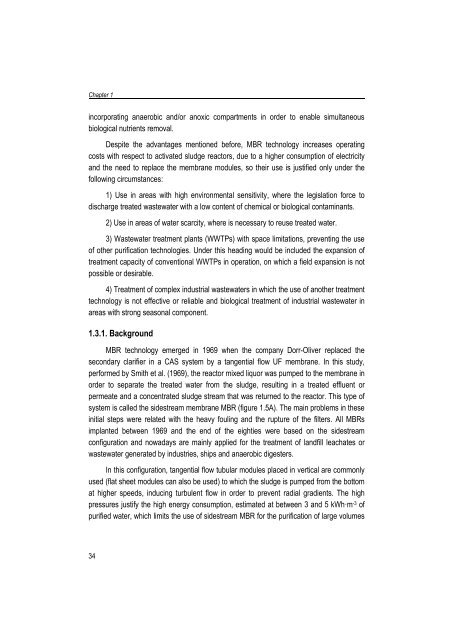Combining submerged membrane technology with anaerobic and ...
Combining submerged membrane technology with anaerobic and ...
Combining submerged membrane technology with anaerobic and ...
You also want an ePaper? Increase the reach of your titles
YUMPU automatically turns print PDFs into web optimized ePapers that Google loves.
Chapter 1incorporating <strong>anaerobic</strong> <strong>and</strong>/or anoxic compartments in order to enable simultaneousbiological nutrients removal.Despite the advantages mentioned before, MBR <strong>technology</strong> increases operatingcosts <strong>with</strong> respect to activated sludge reactors, due to a higher consumption of electricity<strong>and</strong> the need to replace the <strong>membrane</strong> modules, so their use is justified only under thefollowing circumstances:1) Use in areas <strong>with</strong> high environmental sensitivity, where the legislation force todischarge treated wastewater <strong>with</strong> a low content of chemical or biological contaminants.2) Use in areas of water scarcity, where is necessary to reuse treated water.3) Wastewater treatment plants (WWTPs) <strong>with</strong> space limitations, preventing the useof other purification technologies. Under this heading would be included the expansion oftreatment capacity of conventional WWTPs in operation, on which a field expansion is notpossible or desirable.4) Treatment of complex industrial wastewaters in which the use of another treatment<strong>technology</strong> is not effective or reliable <strong>and</strong> biological treatment of industrial wastewater inareas <strong>with</strong> strong seasonal component.1.3.1. BackgroundMBR <strong>technology</strong> emerged in 1969 when the company Dorr-Oliver replaced thesecondary clarifier in a CAS system by a tangential flow UF <strong>membrane</strong>. In this study,performed by Smith et al. (1969), the reactor mixed liquor was pumped to the <strong>membrane</strong> inorder to separate the treated water from the sludge, resulting in a treated effluent orpermeate <strong>and</strong> a concentrated sludge stream that was returned to the reactor. This type ofsystem is called the sidestream <strong>membrane</strong> MBR (figure 1.5A). The main problems in theseinitial steps were related <strong>with</strong> the heavy fouling <strong>and</strong> the rupture of the filters. All MBRsimplanted between 1969 <strong>and</strong> the end of the eighties were based on the sidestreamconfiguration <strong>and</strong> nowadays are mainly applied for the treatment of l<strong>and</strong>fill leachates orwastewater generated by industries, ships <strong>and</strong> <strong>anaerobic</strong> digesters.In this configuration, tangential flow tubular modules placed in vertical are commonlyused (flat sheet modules can also be used) to which the sludge is pumped from the bottomat higher speeds, inducing turbulent flow in order to prevent radial gradients. The highpressures justify the high energy consumption, estimated at between 3 <strong>and</strong> 5 kWh·m -3 ofpurified water, which limits the use of sidestream MBR for the purification of large volumes34
















